Tags
Aberdeen Bestiary, Ashmole Bestiary, Beasts, Bestiary, Bodleian Library, illuminated manuscript, Manuscript, Middle age, Oxford
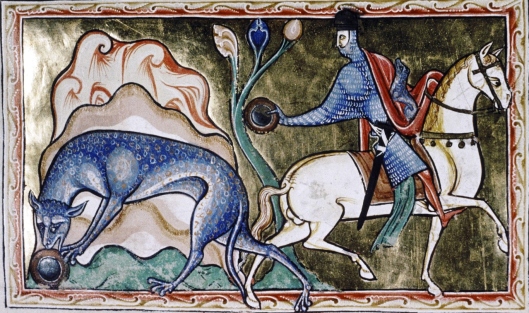 Tiger (Folio 12v). A mother tiger is distracted by a mirror in which she thinks she sees her stolen cub, while the hunter escapes with the cub. (Photo credit: The Medieval Bestiary)
Online Manuscript:
http://treasures.bodleian.ox.ac.uk/The-Ashmole-Bestiary
Tiger (Folio 12v). A mother tiger is distracted by a mirror in which she thinks she sees her stolen cub, while the hunter escapes with the cub. (Photo credit: The Medieval Bestiary)
Online Manuscript:
http://treasures.bodleian.ox.ac.uk/The-Ashmole-Bestiary
- The Ashmole Bestiary is housed in the Bodleian Library [Oxford University], MS. Ashmole 1511
- It is a 13th-century (1200s) illuminated manuscript, as is the Aberdeen Manuscript.
- It consists of 122 folios measuring 27.5 cm (height) by 18 cm (width)
- The parchment is Vellum (calfskin)
- The calligraphy is Littera textualis formata (font)
- Codex: http://en.wikipedia.org/wiki/Codex
—ooo—
- Ashmole Bestiary: http://en.wikipedia.org/wiki/Ashmole_Bestiary
- The Ashmole Manuscript: http://bestiary.ca/manuscripts/manu556.htm
- Treasures of the Bodleian: http://treasures.bodleian.ox.ac.uk/The-Ashmole-Bestiary
- Aberdeen Bestiary: http://en.wikipedia.org/wiki/Aberdeen_Bestiary
- The Aberdeen Manuscript: http://bestiary.ca/manuscripts/manu100.htm
- Illuminated Manuscript: http://en.wikipedia.org/wiki/Illuminated_manuscript
The Ashmole Manuscript
First, I must apologize. My post on the Aberdeen Bestiary had lost several paragraphs when I published it. I did not notice that my text was incomplete until later in the day. I have now rewritten the missing paragraphs and have posted my article again.
The current post deals with the Ashmole or Ashmolean Bestiary (the two names are used) and it is believed that it was illuminated by the same artist as the The Aberdeen Manuscript which originated in England and was probably illuminated in Lincolnshire or Yorkshire. But, the current post also contains information regarding the history of books.
The Story of Books
The Parchment: sheepskin, goatskin and calfskin
I have written about the paper, or parchment, used by artists illuminating books: sheepskin, goatskin and calfskin. The Aberdeen Bestiary was written and illuminated on sheepskin or goatskin. However, the Ashmole Bestiary was written and illuminated on calfskin, or vellum, which is the superior paper.
Wax Tablets: Early Folio
(please click on the image to enlarge it)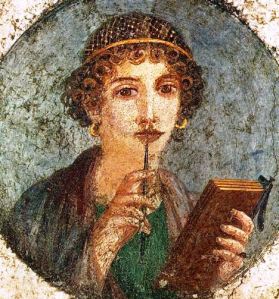 Woman holding wax tablets in the form of the codex. Wall painting from Pompeii, before 79 D.
Woman holding wax tablets in the form of the codex. Wall painting from Pompeii, before 79 D.
Bookbinding: the Codex
Both the Aberdeen and the Ashmole manuscripts are codices, the plural form for codex. Codices are books as we know them, i.e. we go from page to page sequentially. However, the binding used in the Middle Ages was of better quality. The pages were connected to one another using a thread. Some illuminated manuscripts were left unbound so one could see the illuminations in full. But, the pages were eventually bound together, which had one important advantage: pages could not be stolen. The Aberdeen Bestiary has incisions, i.e. someone cut out part of certain folios (feuilles, leaf). That’s unfortunate, but we at least know that part of the page is missing. How can we tell when the entire page has been taken away?
The Folio
Codices contained sequential folios (leaf, page), which was not the case when books were written as scrolls.
(Please click on the image to enlarge it.)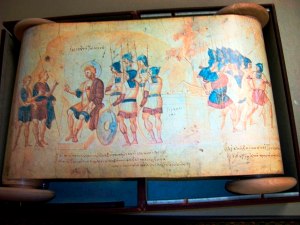
« The Joshua Scroll », Vatican Library, example of an illuminated scroll, probably of the 10th century, created in the Byzantine empire (Photo credit: Wikipedia)
The Codex and the Scroll: volumen, rotulus & recto-verso
Codices (the codex) were introduced in Late Antiquity and continued developing until the Middle Ages. The scroll was probably replaced by the 6th century AD. Scrolls were read from side to side (volumen) or from top to bottom (rotulus). Ironically, when we read information on the internet, we use the scroll!
According to Wikipedia, “The scholarly study of these manuscripts from the point of view of the bookbinding craft is called codicology; the study of ancient documents in general is called paleography.” (Codex, Wikipedia.)
There was a time, moreover, when only one side of the folio (the page) was illuminated and written on (calligraphy). In other words, the sequential codex did not have a recto-verso. The terms Recto and Verso predate the printing-press. (Recto and Verso, Wikipedia.)
The Ashmole Bestiary
The Ashmole Bestiary is a an early Gothic (Christianized) manuscript. By and large, it features animals that cannot be found in Europe, except for a few. As we know, Bestiaries provided depictions of mythical and mythological, or both, animals. In the case of real animals, information was often obtained from the written accounts of travelers to foreign lands. Such accounts did not provide artists with information that could lead to accurate portrayals of various beasts, a case where the proverbial “picture is worth a thousand words” applies. Short of a picture, a tiger might not look like a tiger.
I should think, however, that former portrayals of exotic animals often sufficed. If literature is written in the context of literature (intertextualité), the same is probably true of animal lore, which is illustrated literature.
All bestiaries are derived from the Physiologus and from other rather old descriptions of animals. The authors of these descriptions have been listed: Isidore of Seville, Gaius Julius Solinus, Claudius Aelianus or Aelian, or earlier historians, mainly: Pliny the Elder, Aristotle and Herodotus. This is not a complete list, but I believe that providing other sources would be overwhelming and a little redundant. Moreover, my post would be too long.
However, if one clicks on The Ashmole Bestiary, one can see a depiction of animals presented in the Ashmole Bestiary. If one clicks on Treasures of the Bodleian, one will find a short description of the Ashmole Bestiary provided by a Bodleian scholar. As stated above, the Ashmole Bestiary is housed at Oxford, in one of the Bodleian libraries.
You may wish to look at Gothic art, which is the art associated with Cathedrals such as Notre-Dame de Paris and certain scripts used in Bestiaries. Gothic art followed Romanesque art, starting in the mid 1200s and was followed by Renaissance art. These are large categories, but I have always found it useful to begin with large categories. It simplifies the presentation of most subjects. The rest follows naturally. There will be, of course, an early Gothic and a late Gothic.
There are a few more points I wish to discuss concerning illuminated manuscripts. I have not discussed Richard de Fournival’s Bestiaire d’Amour. We may also wish to look at what was happening at the court of Eleanor of Aquitaine (1122 or 1124 – 1 April 1204).
Tiny Gallery
(Please click on the images to enlarge them. It should work.) (Photo credit: The Treasures of the Bodleian [above image] & The Medieval Bestiary [4])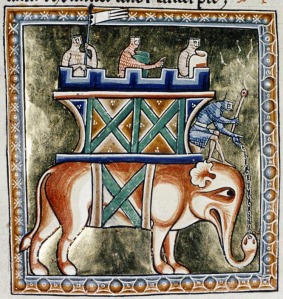
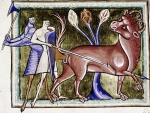
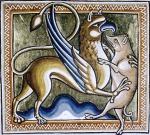 Folio 78v: Treasures of the Bodleian (Dragon strangling an elephant.)
Folio 15v: Elephant (An elephant with a chain through its trunk carries a castle full of soldiers on its back.)
Folio 18r: Bonnacon (The hunters have come prepared with shields, so the bonnacon’s primary weapon has failed to save it from the spear.)
Folio 15v: Griffin (A griffin has caught an unfortunate pig.)
Folio 71r: Swan (The swan sings sweetest when it is about to die.)
Camille Saint-Saëns (9 October 1835 – 16 December 1921)
Le Carnaval des animaux (Le Cygne/The Swan)
Folio 78v: Treasures of the Bodleian (Dragon strangling an elephant.)
Folio 15v: Elephant (An elephant with a chain through its trunk carries a castle full of soldiers on its back.)
Folio 18r: Bonnacon (The hunters have come prepared with shields, so the bonnacon’s primary weapon has failed to save it from the spear.)
Folio 15v: Griffin (A griffin has caught an unfortunate pig.)
Folio 71r: Swan (The swan sings sweetest when it is about to die.)
Camille Saint-Saëns (9 October 1835 – 16 December 1921)
Le Carnaval des animaux (Le Cygne/The Swan)
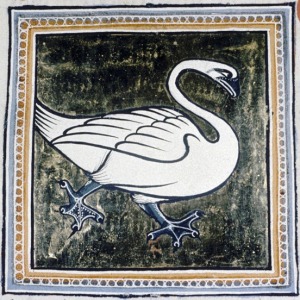 © Micheline Walker
1 March 2013
WordPress
© Micheline Walker
1 March 2013
WordPress

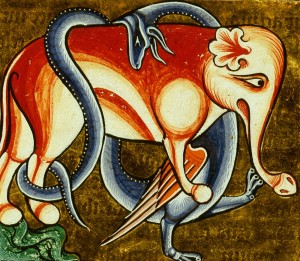

Spotted tigers and frilly eared elephants; delightful. I must admit the first time I saw the animals in a Kenyan wildlife park I wondered what world I had entered. The strangeness I felt on that safari is actually well reflected in the creatures portrayed in the Bestiary.
LikeLike
Dear Gallivanta,
Those animals are so fanciful. The artists were using written descriptions. It shows and I’m glad it shows. Many of the artists and scribes were in monastery. Making illuminations probably gave them great pleasure.
Take care my dear,
Micheline
LikeLike
HI Micheline,
Another great post! I am very drawn to the woman from Pompeii, holding the wax tablet.
LikeLike
Hi Naomi,
I apologize for the delay in answering your note. I have “uneven sight.”
The picture of the woman from Pompeii is absolutely delightful. There are treasures on the internet.
My best regards,
Micheline
LikeLike
Another feast, today, Micheline! Thank you for this. It is such a beautiful summary of this fascinating manuscript.
LikeLike
Your choice of music never fails to delight, Micheline…
A dalliance of delight…!
Hoping you are well, Micheline..
LikeLike
Dear Carolyn,
Yes, I am well, but I have uneven eyesight. One eye has been operated on and I can see with extraordinary clarity using that eye. However, the other eye has not been operated on. Until both eyes have been corrected, I will not see very well.
As for the music, it has been a life long my passion.
I hope you are well.
Thank you Carolyn
LikeLike
I am so pleased to hear the operation was a success; you must be happy about that. I can appreciate it must be a little disconcerting though, to have ‘uneven sight’.
My brother was right then. He maintains he has extraordinary vision now after having both eyes done. Here’s to great vision, Micheline… Cheers.. 🙂
LikeLike
Dear Carolyn,
I apologize for the delay in answering your note. I have “uneven sight.”
Fortunately, the doctor tells me I will not have to wait very long for the second operation. The first one was a miracle. I will not need to wear glasses or contact lenses anymore.
I have never seen so clearly.
Take good care of yourself.
Love,
Micheline
LikeLike